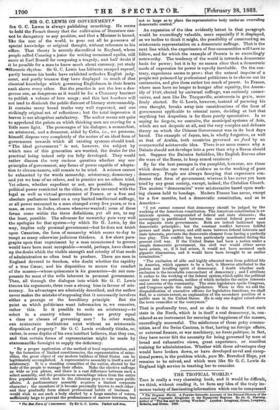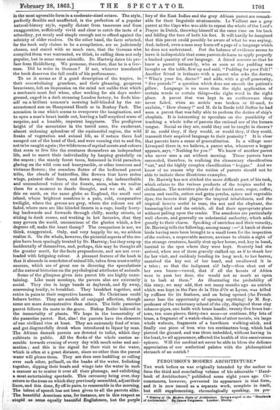THE TROPICAL WORLD.* THIS is really a very charming book,
and it would be difficult, we think, without reading it, to form any idea of the truly im- mense variety of fascinatinginformation which can be compressed
* The Tropical World. A Popular Scientific Account of the Natural History of" Me Animal and Vegetable Kingdoms in the Equatorial Regions. By Dr. G. Hartwig, author of "The Sea and its Living Wonders.' London: Longman, Green, Longman, Roberts, and Green. 1869. in the-most agreeable form in &moderate-sized octavo. The style, _perfectly flexible and unaffected, is the perfection of a popular natural-history style, equally distant from tameness and from exaggeration, sufficiently vivid and clear to catch the taste of a schoolboy, yet manly and simple enough not to offend against the sobriety of older readers. On the other hand, the facts selected, for the book only claims to be a compilation, are so judiciously chosen, and stated with so much care, that the German who compiled them was warranted, we think, in calling them not only popular, but in some sense scientific. Dr. Hartwig dates his pre- face from Heidelberg. We presume, therefore, that he is a Ger- man. Did he write in German ? If not, whoever translated the book deserves the full credit of his performance.
To us it seems as if a good description of the tropics, in their overwhelming grandeur, and their gleaming, gorgeous luxuriance, left an impression on the mind not unlike that which a mechanic must feel when, after working for six days under- ground, caged in a dark steaming London factory, he finds him- self on a brillant summer's morning half-blinded by the un- accustomed sun on Hampstead Heath or in Bushey Park. The sensation is one which seems to overpower the imagination, and to open a man's heart inside out, leaving a half-sceptical sense of surprise, and a humble, impotent happiness. The prodigious height of the mountains in the torrid zone, the exuberant, almost sickening splendour of the equinoctial region, the wild freaks of vegetation and animal life, as if nature there had escaped out of the hand of God, and were running riot to and fro, not to be caught again ; the wilderness of myriad scents and colours that seem to live like the creatures themselves an independent life, and to assert their individuality by harping gratefully on the senses ; the stately forest trees, festooned in livid parasites, glaring on the wild rose and honeysuckle, or other innocent and virtuous flowers; the ceaseless flutter of the bedizened parrot tribe, the clouds of butterflies, like flowers that have stolen wings, painted their faces, and flown away ; the indescribable and unnumbered voices of the forests, seem, when we realize them for a moment to dazzle thought, and we ask, is all this on earth, on the same globe as England, the small cool island, whose brightest sunshine is a pale, cold, comparative twilight, where the greens are grey, where the colours are all faded, where men are like blinded linnets in a cage, busily hurry- ing backwards and forwards through chilly, murky streets, or sitting in dank rooms, and working in hot factories, that they may govern the world, unconscious of the glories which, a few degrees off, make the heart thump? The comparison is not, we think, exaggerated. Only, and very happily for us, we seldom realize it. On the whole, however, the pictorial aspects of the tro- pics have been spatiugly treated by Dr. Hartwig; but they crop up incidentally of themselves, and, perhaps, this may be thought all the greater merit, for the facts preponderate, and are not over- loaded with fatiguing colour. A pleasant feature of the book is that it abounds in anecdotes of animal life, taken from trustworthy sources, which are of great use in directing the speculations of the natural historian on the psychological attributes of animals.
Some of the glimpses given into parrot life are highly enter- taining. Like most monkeys, the parrots also are extremely social. They rise in large bands at daybreak, and fly away, conversing loudly, to breakfast. They breakfast together, and retire in pairs to their respective haunts. No Christians could behave better. They are models of conjugal affection, though some are more demonstrative than others. The little passerine parrot follows its mate to the grave. Bishop Butler believed in the immortality of plants. We hope in the immortality of the passerine parrot. But, alas! the parrots have the elements of one civilized vice at least. They are extremely fond of wine, and get disgracefully drunk when introduced to liquor by man. The African damask parrots are devoted to toilet, which they cultivate in public. All the flocks of the whole canton as semble towards evening of every day with much noise and ani- mation ; and this is the signal for their visit to the water, which is often at a great distance, since no other than the purest water will please them. They are then seen huddling or rolling over each other, pellmell, on the banks of the water, frolicking together, dipping their heads and wings into the water in such a manner as to scatter it over all their plumage, and exhibiting a most entertaining spectacle. This ceremony being over, they return to the trees on which they previously assembled, adj ust their linen, and this done, fly off in pairs, to reassemble in the morning. The talent of speech has not been given to all the parrots alike. The beautiful American aras, for instance, are in this respect as -stupid as some equally beautiful Englishmen, but the purple
lory of the East Indies and the grey African parrot are remark- able for their linguistic attainments. Le Valliant saw a grey parrot at the Cape who was able to repeat the whole of the Lord's Prayer in Dutch, throwing himself at the same time on his back and folding the toes of both his feet. It will hardly be imagined that this parrot could possibly be aware of what he was saying. And, indeed, even a matt may learn off a page of a language which he does not understand. But the balance of evidence seems to leave it indisputable that some parrots do learn to apply properly a limited quantity of our language. A friend assures us that he
knew a parrot intimately, who as soon as the pudding was brought on the table, flew up and said, "Pudding for poor Poll r'
Another friend is intimate with a parrot who asks the doctor,.
" What's your fee, doctor?" and adds, with a gruff generosity, " five pounds?" a question which does not smooth the patient's pillow. Language is no more than the right application of certain words to certain things—the right word in the righb place. A parrot that was kept in an earthenware shop never failed, when an article was broken or ill-used, to exclaim, " How clumsy !" and M. de la Borde told Butfon he had seen a parrot that was fully able to perform the duties of ship's chaplain. It is interesting to speculate on the possibility of teaching a whole tribe of parrots the rational use of the human tongue. Social as they are, could they not be taught in classes ?
If so, could they, if they would, or would they, if they could, transmit their acquired language to their posterity ? It is clear that parrots have a sense of generalization. In a village near Liverpool there is, we believe, a parrot who, whenever a beggar appears, says, " Nothing for you !" We know of another parrot who never sees a cat without mewing. These parrots have succeeded, therefore, in realizing the elementary classification "cat," and the highly complex classification " beggar." And we know of no reason why the nation of parrots should not be able to imitate these illustrious examples.
Dr. Hartwig has not shirked the more difficult part of his task, which relates to the various products of the tropics useful to civilization. The nutritive plants of the torrid zone, sugar, coffee, cocoa and vanilla, cotton and gutta percha, spices and vegetable dyes, the insects that plague the tropical inhabitants, and the tropical insects useful to man, the ant and the elephant, the bumming-bird and the ostrich, all find their appropriate place without palling upon the reader. The anecdotes are particularly well chosen, and generally on substantial authority, which adds greatly to their charm. Speaking of ostriches and their voracity, Dr. Hartwig tells the 'following, among many :—" A batch of these birds having once been brought to a small town for the inspection of the curious, a respectable matron, anxious to obtain a sight of the strange creatures, hastily shut up her house, and, key in band, hurried to the spot where they were kept. Scarcely had she arrived, when one of them gravely stalked up, as if to thank her for her visit, and suddenly bending its long 'neck, to her horror, snatched the key out of her hand, and swallowed it in a trice ; so that the indignant old lady—thus shut out of her own house—vowed, that if all the beasts of Africa were to pass her door, she would not so much as open it to look at them." As illustrating the probability of this story, we may add, that not many months ago an ostrich which was kept in the Parc de la Tete d'Or at Lyons, was killed by ruffians for its feathers, and on being opened (the French never lose the opportunity of opening anything) by M. Rey, professor of the veterinary school of the city, displayed three clay tobacco-pipes, one knife with brass handle, twenty-five brass but- tons, ten sous-pieces, thirty-two sous—or centimes, fifty bits of brass, a fragment of a watch-chain, bits of other metals, six large whole walnuts, fragments of a hawthorn walking-stick, and finally one piece of iron wire ten centimetres long, which had pierced the gizzard, and was there imbedded, without having in the least, to all appearance, affected the health of this omnivorous epicure. Will the medical art never be able to bless the delicate appreciation of our testhetical palates with the philosophical stomach of an ostrich ?































 Previous page
Previous page